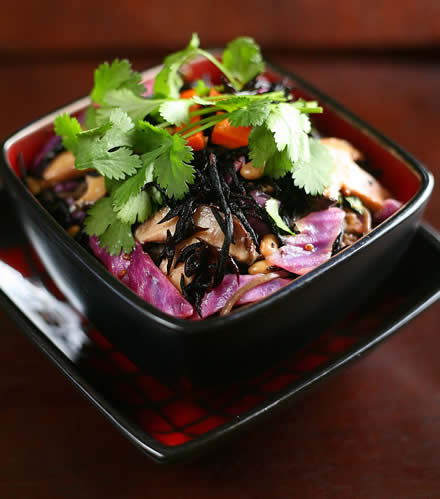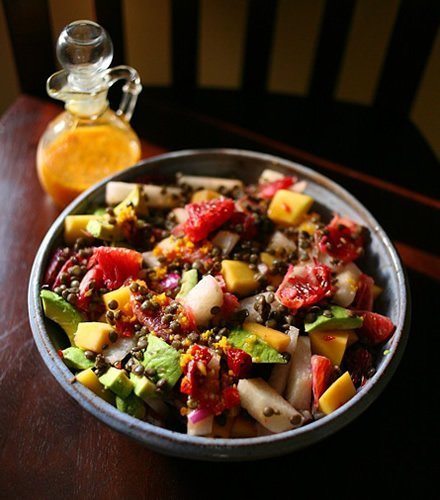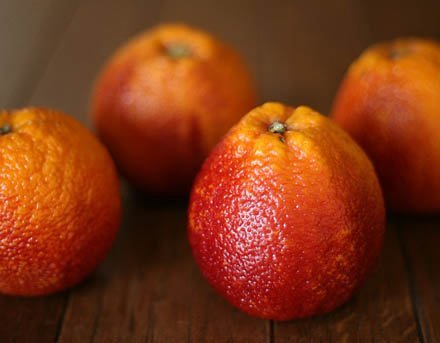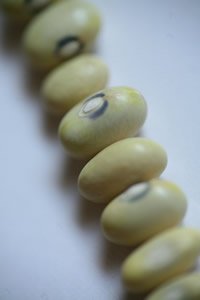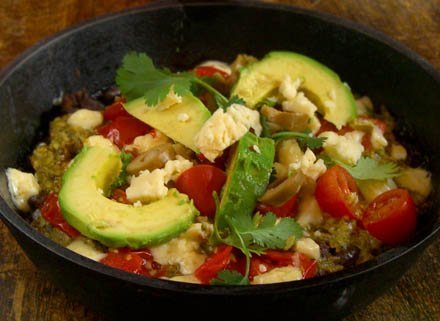
(Vegetarian, Vegan option, Gluten-free)
I’ve been wondering if you can brown beans in a skillet. I mean, given enough mashing and oil, I know you can. Take falafel or black bean burgers, for instance. But it’s a real shame to puree pretty little heirlooms, and I hoped that beans could maintain their individuality while getting a tan. Turns out, they can.
I got this idea in my head to make a skillet taco. I wanted golden, almost crunchy beans, topped with a nice tomatillo salsa, salty green olives, and a soft Mexican cheese that would melt on contact. I had no clue as to whether any of it would work, individually or as a dish. But after a few bites, the unanimous verdict was “yum!”
A purist would tell me it can’t be a taco without a shell. Nevertheless, that’s how I served it, straight out of the skillet onto a plate. It would no doubt fill a shell nicely though, so feel free. This dish actually reminds me more of an Indian taco rather than a Mexican one, so Indian Fry bread might be nice. I’m a terrible fryer – it makes the house stink, things come out soggy, and it’s bad for me to boot, so generally I just don’t even try. When I make Indian bread I end up baking it instead, and it works fine. If you don’t have a recipe (perhaps I’ll post one later) you could use oven-warmed pita bread.
The beans I used for this dish make me giddy. Here’s a long name: Hopi Purple String/ Rio Zape. Obtained from Native Seeds/SEARCH, this bean was recovered from the ruins of the Anasazi cliff-dwelling people in the American southwest desert. I also just learned that this one has made the Slow Foods Ark of Taste (like the Hutterite bean), and I concur with their decision. A deep reddish purple color, the beans have burgundy-black markings and semi-retain them after they’re cooked. The beans contain a hint of chocolate and smoke — which would make them perfect for chili — and a creamy texture.
The tomatillo salsa is the real highlight of this skillet taco. I know, I know, extra steps, but I promise you, it’s so totally worth it. This salsa knocked me out with its bright, vibrant, citrus-y flavor, and it really pulled together the flavors in the skillet. Double the recipe (but you’ll need two skillets to cook it down) and save some for later – it will make any Mexican or Southwest dish pop.
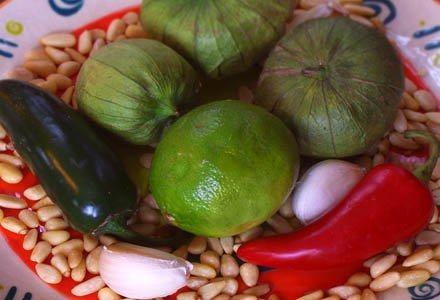
The recipe:
Skillet Tacos
2-3 tablespoons olive oil
4 cups cooked Hopi Purple String/Rio Zape beans
2 tablespoons chili powder
1 1/2 tablespoons cumin
1 teaspoon oregano
3 teaspoons smoked paprika
1 teaspoon sweet paprika
1 teaspoon chipotle pepper
1 teaspoon salt – or to taste1 teaspoon fresh ground black pepper
½ teaspoon cinnamon
¼ teaspoon allspice
Enough tomatillo salsa to cover the beans (recipe follows)
1 clove garlic, minced
1 red bell pepper, or a poblano for a mild spiciness, chopped
1 cup cherry tomatoes, cut in half
1/3 cup green olives, sliced into rings
1 cup Chihuahua cheese, crumbled or cut into very small pieces
½ cup cilantro
1 lime
1 avocado
Heat 1 tablespoon of olive oil in a skillet, and sauté garlic and peppers until translucent. Add tomatoes and cook until they are just soft. Remove from skillet and stir in ¼ cup of the chopped cilantro.
In a bowl, stir Hopi Purple beans with one tablespoon of the olive oil, until they are well coated. If you need more oil, add it gradually – you don’t want to saturate the beans. In the skillet, add enough olive oil to coat the bottom of pan and turn heat to medium. When oil is hot, add beans to skillet. Stir in the chili powder, cumin, sweet and smoked paprika, oregano, chipotle, salt, pepper, cinnamon and allspice. Stir beans well to combine spices and coat beans, and let cook 4 minutes, stirring now and then. As best as you can, flip the beans and then let cook without stirring for another four minutes, until they begin to brown on the bottom.
Turn heat to low and spread tomatillo salsa over the beans. Add sautéed vegetables, then garnish with olives and cheese. Place a cover on top of skillet and let warm through until the cheese gets soft. Remove from heat, garnish with cilantro and avocado, and then squeeze lime juice over the finished taco. Eat it as is, or scoop some into taco shells or onto flat bread. Enjoy!
Tomatillo Salsa
1 cup pine nuts6 large garlic cloves, peeled and halved
10 tomatillos, husked, rinsed, and halved
1 jalapeno, seeded and halved
1/4 bunch cilantro, stemmed
1/4 bunch parsley, stemmed2 teaspoons sea salt
1 1/2 cups vegetable broth
2 tablespoons olive oil
Line a heavy skillet (preferably cast-iron; not nonstick) with foil, then heat over moderately high heat until hot. Add half the tomatillos, cut side down, half the garlic and the jalapeno. Cover with another piece of foil and roast on stovetop until browning, 4 to 5 minutes (and don’t be alarmed if the skillet smokes a bit). Turn vegetables, re-cover, and roast another 3-4 minutes, until tomatillos are soft. Repeat with remaining tomatillos and garlic, then transfer all to a food processor.
Turn heat to medium-high, and when skillet is hot, toast the pine nuts, shaking them to keep them from burning. When they begin to brown, remove from heat and add to the food processor.
Add cilantro, parsley and sea salt, and one cup of the broth. Puree until all ingredients are smooth. If the sauce is thick, add another ½ cup of broth.
Heat a large skillet over high heat, then add the olive oil. When it’s hot, add the tomatillo salsa. Reduce heat to medium and simmer for ½ hour, stirring often. If it gets too thick, add water, ¼ cup at a time. You want the salsa to thicken, but not so much that it lacks moisture and/or spatters. Adjust salt and pepper as necessary.

